Kayaking in Sea of Cortez: The Wine List- Day 16
It was a calm night and there was no wind when I awoke in Bahia Guadalupe and it was a beautiful day for kayaking in Sea of Cortez. I found that the morning low tide uncovered mudflats in the small cove where I had camped. I scoured the area for clams, but I could not find any.
I launched at about 6:30 AM. And about 2-1/2 hours later I landed at Punta Cardin. Along the way, I passed between the shore and Isla Alcatraz which is about 500 yards from the shore. There was a collision of currents here and they formed a wall of choppy water between the shore and the island. The north wind was blowing quite hard, but I hugged the shore to keep from getting blown out to sea, paddling with the wind most of the time. I was not quite opposite the Smith Island volcano when I came to a long barrier beach with a heavy growth of seaweed, the first I’ve seen of this type. The seaweed created a band of calm water parallel to the shore. I paddled down the center of this calm patch of water, with the wind at my back.
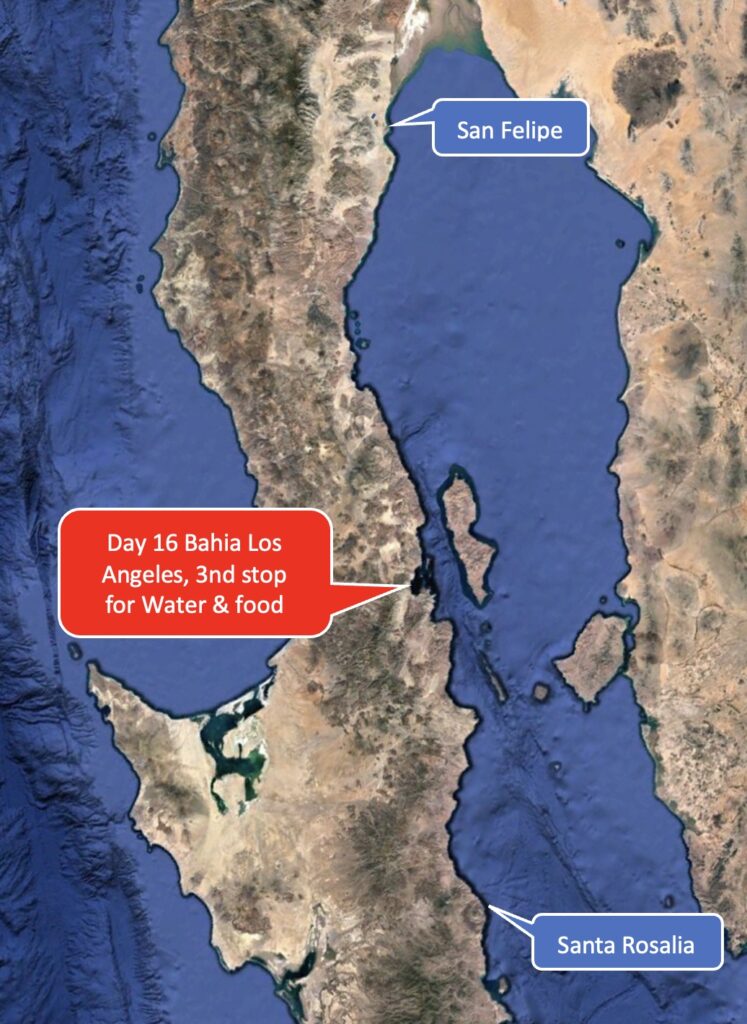
It was a long haul going down to the Bahia de Los Angeles, but I mostly had the wind with me going down past the Bay Islands. I landed to have a rest and a quick snack at Punta La Gringa. From here, I turned west and had a long and potentially dangerous offshore 2-mile crossing of a wide bay with the wind and waves coming from my right side.
As I approached the far shore, I saw a man walking along the beach and it occurred to me that this was the first person I had seen since leaving the fish camp at Calamajue, about six days ago. I had traveled about 70 miles without seeing another person and hardly any evidence of humanity, aside from the flotsam and jetsam of civilization that had washed up on the beach. This solitude, and the feeling that I was the only person in the world, was what I had come for.
When I got to the shore, I turned south and went down about 4 miles of shallow water adjacent to the beach while passing in front of a long row of houses, probably mostly Americans. The wind had blown all day from the north and for most of that I had my life preserver on. I passed by one house that wins the prize for the most creative whale lawn furniture. Basically, it had whale ribs and jawbones standing up from all kinds of places on the property, forming corner posts, archways over the gate, and intermixed with huge backbones of whales.
By about 2:15 I had finished my first margarita and plate of tostadas at Guillermo’s in Bahia de Los Angeles. As I got my second margarita, the radio was playing “oldies but goodies” here at Guillermos: Maybelline, Rock Around The Clock, See Ya Later Alligator, Great Balls of Fire, etc. Totally out of place, but perfect for my mood.
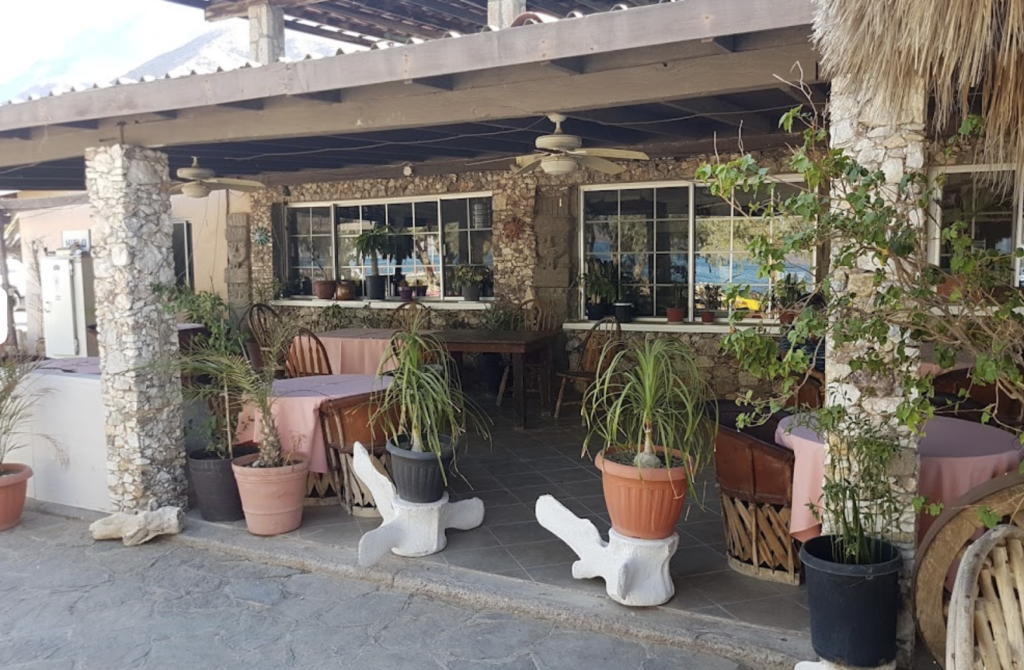
Guillermo’s is an RV camp with a small hotel, and there is also a beach restaurant with a phone. I called my wife Ann from Guillermo’s; she’s having some problems at work but says to go on with my trip.
I needed to start planning for the food and water for the next phase. I cut it pretty close on the last section. I ended the trip here with plenty of water, but only one potato and one can of soup! Not much room to spare if I had been forced to stay an extra night or two because of the wind. Between Bahia de Los Angeles and Santa Rosalia, it’s about 145 miles and there is one place where water might be available called San Francisquito. Everyone I talked to said that water will be available in San Francisquito “if their pump is working”, which was why I had some concern.
I went grocery shopping and got most of what I needed, cost $40.00, including five cans of Spam and a small jar of jam. They have a nice mini market here in Bahia de Los Angeles, it even has two shopping carts. Here is a description of this area from a website that seems no longer be available:
“Distinguished for being one of the most beautiful bays of Mexico, Bahia de Los Angeles is formed by a narrow sandy point backed by the rocky mountains of Calamajue and San Jose. Protecting the bay is Isla del Angel de la Guarda (Guardian Angel Island) making the sea calm and peaceful. Other islands close to the bay are Coronado, Ventana and Cabeza de Caballo. Perhaps the presence of nature’s power and beauty at Bahia de los Angeles is still intact because the hand of man hasn’t touched it yet. Currently, Bahia de los Angeles has a population of just 500 friendly inhabitants, but offers the services of hotels, restaurants, trailer parks, a launch ramp, gas station, grocery stores, a pharmacy, a museum, and a medical clinic. Also, as a tradition in many Mexican towns, Bahia de Los Angeles village has its central plaza. The weather is pleasant and balmy most of the year; July and August are the hottest months.
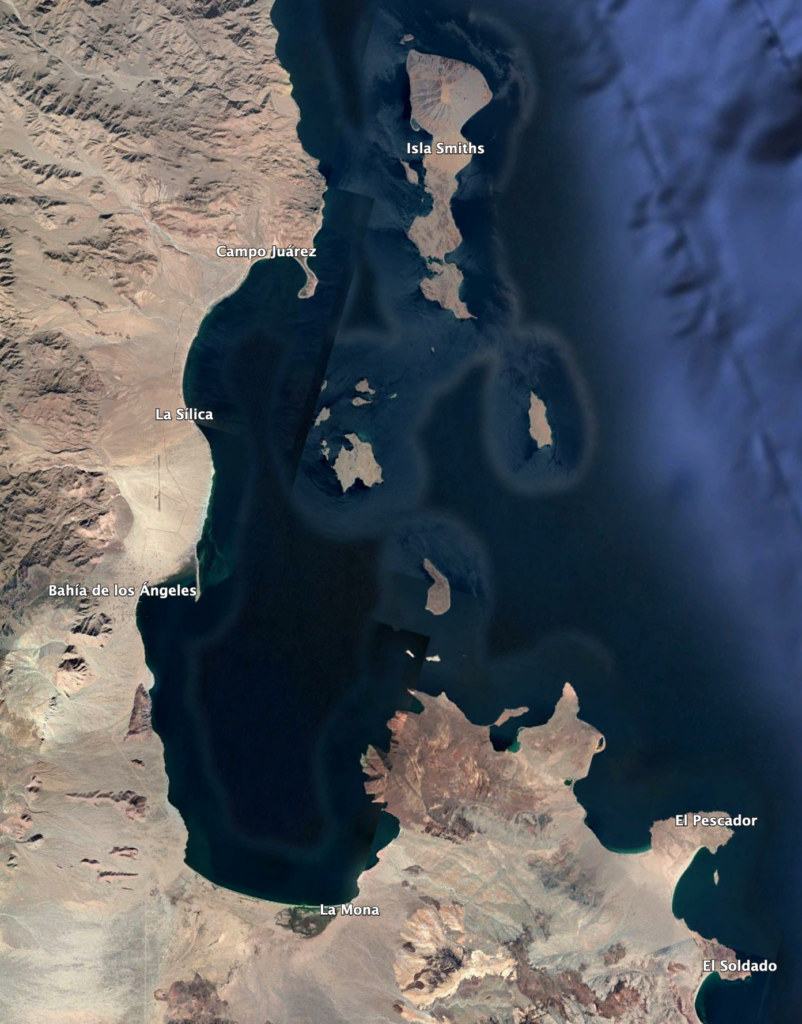
Beginning in the late 1940s, American sport-fishing enthusiasts began flying private planes into Bahía de Los Angeles; a few hardy souls even drove down from San Diego and points north. Old Baja hands say in those days the village was nothing more than thatched-roof huts. But novelist John Steinbeck, who sailed into the bay in early 1940 with marine biologist Ed Ricketts, described his feeling of resentment at finding “new buildings, screened and modern, and on a tiny airfield a plane . . .” Even then, Steinbeck wrote, there were Americans in Bahía de Los Angeles.
Modern concessions to tourism include a small power plant, two trailer parks, a few motels, some cafes, two areas at the north and south end of town for barrel gas only, a museum, and a small park. The major leisure activity remains fishing.”
This description is from Bajabound:
“Almost like a moonscape the road into Bahía de Los Ángeles takes you through arroyos once wild with flood waters, but now deep dry canyons. The force of nature has been captured in the very earth itself. Even so, it is a smooth and easy 30-minute drive in from Highway 1, with just a few sections of road under repair. Then the long sweeping shoreline and the azure-blue water of Bahía de Los Angeles opens out before you. Offshore a backbone of volcanic ridge pushes up out of the water and is joined by many islands. The small quiet town is sandwiched between the bay and Sierra La Libertad, 1300 feet of folded and sculpted mountain. LA Bay, as state side travelers often called it, is a community of very hardy folks. Their lives are wrapped around the sea and fishing. A few foreign residents live in a fairly stark landscape, called “Gringa Point.” The only paved road runs through town. All other roads out to the water front are sandy and wind-swept.”
In the restaurant for an evening dinner at Guillermo’s, I ordered lobster tacos. While I was waiting for my dinner a German couple came in and sat at a nearby table. I overheard their conversation with the waiter, and it seemed their Spanish was quite good. As they perused the menu, they called the waiter over and they asked to see the wine list. The waiter explained there was no “wine list” and only one wine available, as he pointed across the room to a large 4-liter jug of red wine on the bar. The German couple seemed confused and went back to looking at the menu, discussing it in German. They called the waiter back and resumed their inquisition about the wine. They insisted on having wine that came in a bottle, not a jug. They were incredulous when the waiter explained there was no such wine available in Bahia de Los Angeles. After several more exchanges with the waiter that became louder, more animated, and interspersed with German, they jumped up from the table and left, slamming the door behind them. I presume they went looking for a better class of restaurant.
My order soon came and as I sat there in Guillermo’s enjoying my lobster tacos, I contemplated the expectations of the German couple in this wonderful place that was at that time 45 miles from a paved road. I smiled to myself as I realized that a person’s expectations of a place greatly depended on the journey and not the destination. They, no doubt, drove about 45 miles from Highway 1 on a semi-paved side road in their air-conditioned SUV into this desert town, expecting to toast their travels with a vintage cabernet or perhaps a sweet German Riesling, only to be disappointed. But this place was far from anywhere in both distance and time. Traveling solo, I had just paddled a heavily loaded kayak almost 200 miles over sixteen days, chased coyotes making off with my clothes, and sparingly used my food and water so that I could make it here to Guillermo’s. I landed in this wonderful place with a single potato and one can of soup to spare. I turned to the waiter who was still looking at the door pondering the meaning of the rude exit by the Germans, and I said, “Por favor, Senor, pour me a glass of wine from that big jug. Very nice! Muchas gracias!”
I arranged to sleep on the beach next to my kayak in front of Guillermo’s and I took a nice hot shower in the RV park. I really like Bahia de Los Angeles.
Next: Day 17 – Where Are All the Fish? See also “The Wine List”
Please comment on Two Miles to the Horizon
Back to the beginning of Two Miles to the Horizon

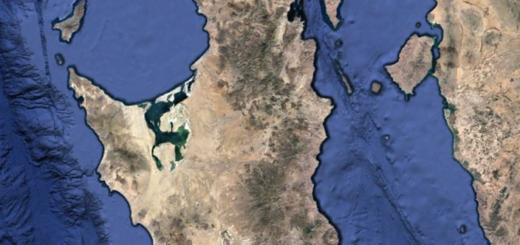
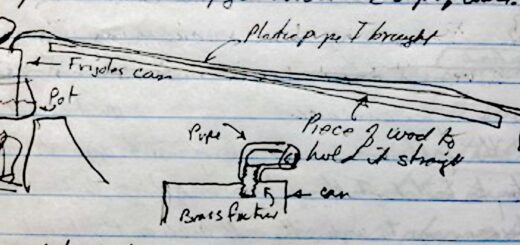


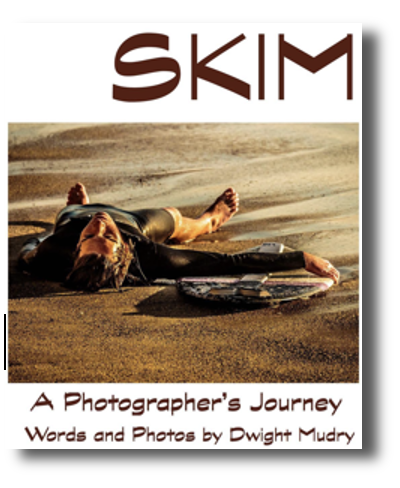

2 Responses
[…] Next: Day 16 – “The Wine List” […]
[…] Day 16 – The Wine List […]